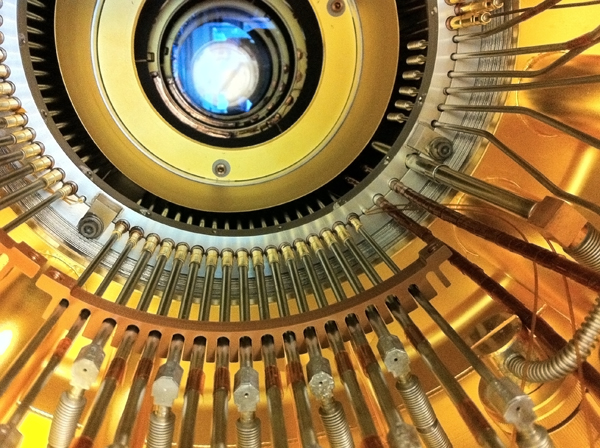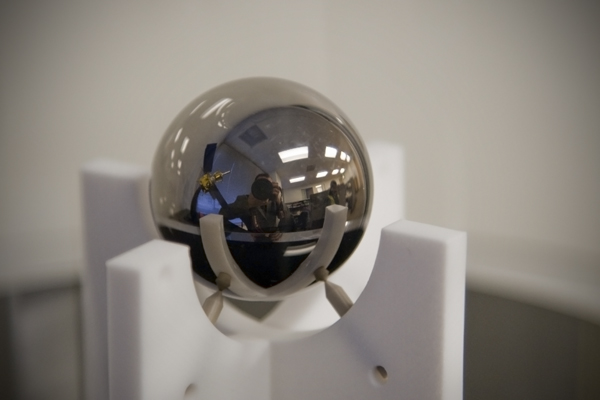I had to post an entry on this subject as it was a bit of a find discovered in the hall of the astrophysics building at Stanford. I originally ran into it on a visit to friends that I am collaborating with on some very exciting retinal research and was fascinated by the Gravity Probe B sitting in the hallway. Looking deep into the probe provides some pretty interesting imagery and I made pictures of it on both recent visits. The image above came from the most recent visit.
As an aside, the introductory image was shot with my iPhone and is the second image that I’ve posted on Jonesblog that was made with the iPhone after the image of the borked hard drive. The camera in the iPhone 4 is now good enough that I feel comfortable posting images in the blog from it.
The image above is a shot originally posted here on Jonesblog of one of my previous visits to Stanford. As I said back then, this sphere is one of the most perfect spheres ever created on this planet. A smoother sphere cannot be found this side of a neutron star. As I had said previously, this little innocuous ball was sitting on a shelf outside my colleagues office and I found myself staring at it. Only after the occupant of the office next door walked in did I find out how special this little sphere was. It turns out that this sphere was one of several that were created to test Einstein’s theory of relativity. This is the explanation from The Gravity Probe-B’s website:
These spheres are made “of pure fused quartz, polished to within a few atomic layers of perfectly smooth. In fact, the GP-B gyro rotors are now listed in the Guinness Database of World Records as being the roundest objects ever manufactured, topped in sphericity only by neutron stars.
The spherical rotors are the heart of each GP-B gyroscope.They were carved out of pure quartz blocks, grown in Brazil and then fused (baked) and refined in a laboratory in Germany. The interior composition of each gyro rotor is homogeneous to within two parts in a million. On its surface, each gyroscope rotor is less than three ten-millionths of an inch from perfect sphericity. This means that every point on the surface of the rotor is the exact same distance from the center of the rotor to within 3×10-7 inches.”
Pretty cool stuff…


I feel like this is a really, really dumb question. . . but can you touch it?
Surprisingly… the probe is just sitting in the hall and yes, you can touch that. The sphere is not available for touching.
You wrote: “refined in a laboratory in Germany”
Is that Zeiss? If so, then they apparently didn’t botch it like Hubble’s mirror.
Dunno where the rotors were made or which laboratory did them… Was it a German lab that borked the Hubble mirror? I thought it was a US lab?